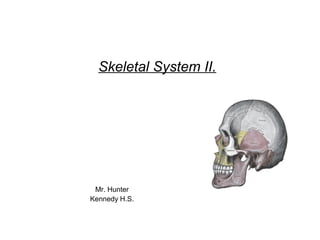
Anatomy and PhysiologySkeletal system II
- 1. Skeletal System II. Mr. Hunter Kennedy H.S.
- 2. Mr. Hunter Anatomy and Physiology 11.15.2012 • Objective(s) • SWBAT • List the 5 regions of the spine • Describe the structure of vertebrae • Distinguish true ribs from false ribs and their attachment sites • Describe articulations of the upper extremities of axial and appendicular skeleton Bell Ringer: What is the name of the location marked X on the skeleton model?__________
- 3. Vertebral Column • Consists of a series of vertebrae connected so that they form a flexible curved rod. • Different regions of the spine: cervical, thoracic, lumbar, sacrum and coccyx • (7) cervical, (12) thoracic, (5) lumbar, (1) sacrum and (1) coccyx. • Sacrum = 5 bones in child • Coccyx = 3 to 5 in child
- 4. Vertebral Column • Cervical, thoracic and lumbar vertebrae consists of various parts: • The hole in the center is the vertebral foramen in which the spinal cord travels. • Transverse and articular processes are for controlled movement and rib attachments.
- 5. Vertebral Column Curves • Cervical and lumbar curves of the spine are concave. Thoracic and sacral are convex. • Curves of the spine provide strength to balance and support the weight of the body.
- 6. Thorax and Ribs • Twelve pairs of ribs, the sternum and the thoracic vertebrae form the thorax. • Each of the 12 pairs of ribs are attached posteriorly to a vertebra. • The first 7 pairs of ribs are attached to the sternum by costal cartilage. • The 8th, 9th and 10th pairs are attached to the cartilage of the 7th ribs = false ribs. • The last two pairs of ribs are not attached to any cartilage and appear to float.
- 7. Appendicular Skeleton • The scapula and the clavicle compose the shoulder / pectoral girdle • This connects the upper extremity to the axial skeleton. • This occurs at the sternoclavicular joint – The point of attachment between the clavicle and the sternum. • Fractures of the clavicle are common due to small size of the joint and the wide range of motion by the upper extremitiy.
- 8. Appendicular Skeleton • The humerus is the long bone of the arm and the second longest bone in the body. • Attached at the proximal end to the glenoid cavity of the scapula via a group of muscles called the rotator cuff • The distal end of the humerus articulates with the ulna and the radius. • The olecranon process of the ulna fits into the olecranon fossa of the humerus.
- 9. Appendicular Skeleton – Wrist and Hand • The wrist and the hand have more bones for their size than any other part of the body. • 8 carpal – wrist bones, 5 metacarpals – bones of the palm, 14 phalanges – fingers • There are 27 bones total.
- 10. Appendicular Skeleton – Lower Extremity • The pelvic girdle – hip connects the legs to the trunk. • Consists of two large coxal bones located on each side of the pelvis, attached inferiorly to the sacrum of the vertebral canal. • In the infant, the coxal bone consists of the ilium, ischium and the pubis.
- 11. Appendicular Skeleton – Lower Extremity • The femur is the longest bone in the body. It articulates with the coxal bone in a cup- shaped socket called the acetabulum. • Distally, the femur articulates with the patella - knee cap at the medial condyle of the tibia – shinbone. • The fibula lies along the outer lateral border of the leg.
- 12. Appendicular Skeleton – Foot and Ankle • Toe bones have the same as finger bones – phalanges. • Metatarsals and tarsals are located in the foot • Each foot has (5) metatarsal bones, and (7) tarsal bones and (14) phalanges • The largest tarsal bone is the calcaneous – heel bone
- 13. Appendicular Skeleton – Foot and Ankle • Strong ligaments and tendons hold the foot bones in a normal arched position for adequate support of body weight. • When the tendons or ligaments become damaged the arches can collapse – flat feet. • Two arches of the foot: Transverse and Longitudinal
- 14. Differences Between Male and Female Skeleton • Most male skeletons have larger bones due to skeletal muscle attachments. • The greater the tension on the bone via muscle attachments, the larger and denser the bone becomes at the point of attachment. • The coxal bones are also different. • The pubic angle in the female is wider than that of the male for the purpose of childbearing.
- 15. Skeletal Joints • Every bone in the body connects to at least one other bone via joints with the exception of the hyoid bone. • Joints allow movement to occur between certain bones. • They also hold our bones securely together.
- 16. Skeletal Joints • Synarthroses – no movement. Fibrous connective tissue joins the articulating bones and holds them close together. Ex. Cranial bones – sutures. • Amphiarthroses – slight movement. A joint in which cartilage joins the articulating bones. Ex. Joint between the two pubic bones and the joints between the body of vertebrae • Diarthroses – free movement.
- 17. Types of Skeletal Joints • There are several types of diarthroses. • Ball and socket joint • Hinge joint • Saddle joint • Pivot joint • Gliding joint • Condyloid joint • Different joint structures provide different ranges of motion. • Flexion, Extension,Rotation • Circumduction, Abduction and Adduction
- 18. Types of Skeletal Joints • Different joint structures provide different ranges of motion. • Flexion, Extension,Rotation • Circumduction, Abduction and Adduction • Pg. -131-132 • Read pgs. 141-145 • Answer Quick Check pg. 145 # 1-3